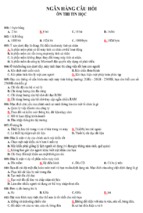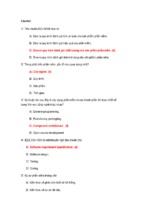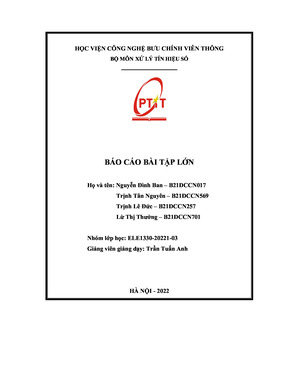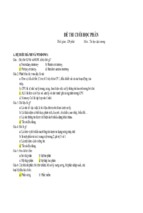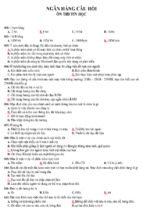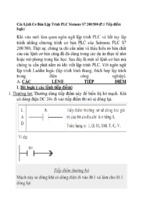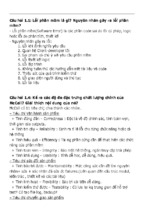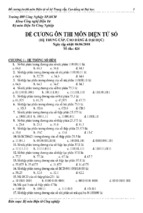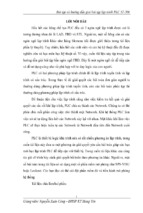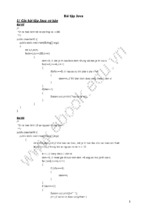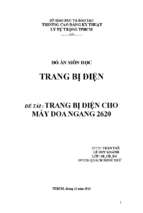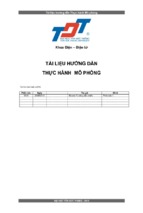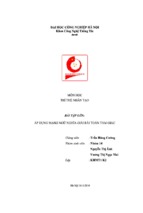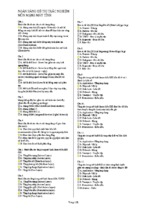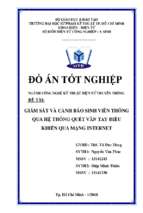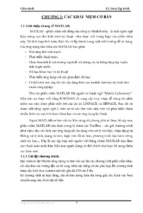Introduction
By now you've seen all the hype, read all the books, and discovered all the wonders of
Java. But most of us still use C++ or C to create our hard-core applications, saving
Java for our Web pages or leaving it to HTML jocks to fiddle with. Doing so denies
us the opportunity to use a programming language that makes interfacing with a
computer infinitely easier, with less frustration and faster results.
Java is much more than "Dancing Dukes" or a programming language for Web pages.
It is a strong alternative to the masochistic programming of the past, in which
countless months were spent debugging compared to the mere days it took to code the
initial concept. Java allows us to spend more time in the conceptual phase of software
design, thinking up new and creative ways to bring the vast knowledge of the Internet
and its many users to our desktop.
Today, our information, and its steady flow, is garnered from the Internet and the
millions of fellow computer users around the world. Up until now, you've no doubt
designed programs to interface with that knowledge using C or C++. Java will change
all of that. In addition to its ability to create adorable and functional user interfaces
quickly and easily is Java's ability to easily connect to the Internet. Java is, after
all,the Internet Language.
What This Book Is All About
Advanced Java Networking is designed to present you with a myriad of alternatives to
connect your applications to the Internet. It is neither a programming reference nor a
marketing brochure. We'll leave that to the geeks and marketeers to battle out. Instead,
we wanted to explore each alternative without marketing bias or engineering snobbery.
One part of the engineering community will tell you that sockets are the only true way
to communicate information over a network. Another segment will say that Java-only
applications relying on Remote Method Invocation (RMI) will solve all your
communication problems. Then, of course, there is the Common Object Request
Broker Architecture (CORBA) camp. We'll discuss these alternatives, and we will
also explore aspects of server-side programming in which we use a Web server as a
mechanism to generate dynamic Web pages that can be connected to databases (and
just about anything else). We present an honest account of each alternative and
guidelines for choosing what's best for your business or programming needs. In
addition to the hundreds of lines of sample code we supply to help you start from
scratch with Java communication, we place an additional emphasis on migration of
your existing desktop-centric applications to an Internet-ready world.
Who Should Read This Book
This book is not for beginning programmers nor is it an introductory Java text. We
assume that you have a strong object-oriented programming background, preferably in
Java. You should have a strong grasp of such Java fundamentals as how to create a
class, how to compile and execute programs on your native system, and how to
deploy Java applications. Furthermore, you should understand a good deal of the
terminology of the object-oriented world.
How to Read This Book
We've conceived this book in parts, with each part further divided in chapters. Each
part addresses one aspect of Internet programming, be it Java Fundamentals; Core
Networking such as RMI, CORBA, or Java Database Connectivity (JDBC);
Advanced Networking like Beans and Web Servers; general Java Networking
information, including a special chapter on Internet security that addresses simple
Applet Security restrictions; or more complex subjects such as Directory Services and
JNDI. We have also included a short chapter that is an introduction to TCP/IP and
how the Internet works. I have found this invaluable as the very first thing that we
cover in the Internet Programming course I teach.
Finally, we want to show you that Java programming is much more than an animation
floating by a Web page or interactive Internet content. Java is a language that can hold
its own in the world of desktop applications and the examples in the book typically
are written as applications rather than as applets. We make no effort to contain our
enthusiasm for Java and certainly don't apologize for our delight in working with it.
We hope that you will come to love this language as much as we have.
Conventions
We use the monospaced Courier font to denote source code and type out our code
listings. If you see a Courier word within a sentence (for example "Java Vectors are
cool"), it is the name of a class or object. We are also firm believers in the step-bystep approach to code samples. Therefore, we have generally shown the entire code
listing and the additions from the previous instance of it. The changes are in Courier
Bold. For example, the first time we show a code snippet, it looks like this:
public class Dick
{
}
And when we make an addition it is bolded:
public class Dick
{
String loves = "Bobbie";
}
Also, when we show a command prompt, the part you type is also bolded:
%prompt% dir c:\games
There are sidebars throughout this book that highlight certain parts of the text, as
follows.
•
•
•
Tips inform you of a special or unique way to accomplish something in Java
networking.
Alerts tell you of any bugs or "gotchas" that you should be aware of while
programming your applications.
Notes simply point out any information that might be useful to you in your
network programming endeavors.
Fixes and Updates
We would also like to take a moment to apologize in advance for any errors. This
book has been a total blast to write, and we might have gotten caught up in our own
excitement here and there. In any event, we hope you have fun reading about and
exploring the Java networked world!
The CD-ROM that accompanies this book (see "About the CD-ROM," at the back of
the book for details regarding the CD-ROM) contains several of the applications that
we have developed in this book. Additionally, a special Web page has been created as
a front-end to navigating the CD-ROM and for linking to related Web sites. To access
that Web page, please load the file named index.html, found in the root directory of
the CD-ROM, into your browser.
To err is human, and the authors of this book are as human as can be. Despite testing
every example thoroughly, both from an installation and compilation perspective,
problems can occur. If we find a problem with any of the programming examples in
this book, we will post a fix as soon as possible on our Web site:
http://www.prenhall.com/~java_sun
This online Web supplement can also be linked to from the Web page included on the
CD-ROM included with this book.
Thanks a Million!
About the time that Prashant Sridharan wrote the first edition of this book, I started
teaching an undergraduate course titled (innocently enough) Internet Programming
(CS-328). My personal goals for the course were that it would be Java based and that
it would cover TCP/IP, sockets programming, the use of databases, and distributed
object programming. In 1997, there were textbooks on networking and textbooks on
Java, but there were no textbooks on networking using Java. I found Prashant's book
in the trade book section of our local bookstore. Topically, it was almost a perfect fit
for the course outline that I had developed. CS-328 began in the fall of 1997, with
Prashant's book as its text. The course has been immensely popular and has been
offered to a full house of juniors and seniors every semester since.
Writing the second edition of this book has been a balancing act that has been
frustrating at times; rewarding in the support of colleagues, friends, and family; and—
to see one's efforts in print—quite satisfying. I had never had the slightest desire to
tackle the task of authoring a book, especially a technology-based book. As an adjunct
faculty member in the Computer Science Department in the T. J. Watson School of
Engineering and Applied Science at Binghamton University (State University of New
York) for the last 25 years, I have taught many different programming courses and
used texts by many authors, from many sources. I found that, after using the same
textbook for several semesters, I would have collected a list of corrections and
suggestions for improvements and updates in order to keep the course material current.
After four semesters (two years—a long time in the life of Java) with the first edition,
I decided that the material in the book was getting a little stale. After all, Java had
progressed to JDK 1.1.7 and the examples in the book were still JDK 1.0. Many of the
predictions made about the course that Java would take had not materialized. The
book cried out for a second edition. Like any good instructor, I phoned the publisher
and eventually was put in touch with Mark Taub. I asked Mark when the second
edition would be out and was told that he wished that he could tell me: Prashant no
longer worked for Sun and had taken a new job at Microsoft (now there's a defection
for you) and didn't have the time required for a second edition. Mark then did
something I never expected and asked innocently, "You seem to know what the book
needs and you've been using it for quite a while, would you be interested in tackling
the second edition?"
After much soul searching and discussion with my wife and my associates in
academia, Les Lander, Margaret Iwobi, and Eileene Head, I called Mark back. I told
Mark that despite my doubts, my associates thought that it would be a good
opportunity for growth (and what else did I have to do with my time?). Conveniently,
they seemed to forget that I work fulltime as an Advisory Programmer at Lockheed
Martin Federal Systems, Owego, New York, where I am also the site Webmaster.
It has been a busy 10 months since my first contact with Mark. I've really had fun
doing this and am really grateful to Mark and Prentice Hall for giving me the
opportunity to investigate and write about Java Networking (one of my favorite
topics). I'm grateful, too, for the help Anne Trowbridge of Prentice Hall gave me with
the CD-ROM that accompanies the book.
There are a number of people that I must credit for their help with getting this book to
market. First and foremost is my wife, Bobbie, to whom I have been married for 32
years. She has patiently supported me through more projects than I care to count.
I owe special thanks to associates at Lockheed Martin: first to my manager MaryLou
Marcotte for letting me divvy up last year's vacation in the strange way that I did to
complete the writing. MaryLou, It's hard adjusting to a normal schedule again.
Scott Rush, our site electronic security guru helped me with the chapter on Java
security.
My very special thanks go to Noah Ternullo. Noah is both a work associate and one
our graduate students at the university. CS-328 is an undergraduate course; however,
because it is an Internet-based course, it attracts a lot of graduate students. Graduate
students wanting to take CS-328 must register for Independent Study, successfully
complete the course, and do an additional research project in a mutually agreed upon
topic in Java networking. They present their project (along with a paper) to the class
at the end of the semester. At the time Noah was a graduate student in my class, Sun
had just announced JINI, and he decided that that was what he wanted to research.
The night that Noah did the class presentation, he and a friend dragged three PCs into
the classroom from their cars and set everything up. One machine was running Linux;
another, NT; and the third, W95. The presentation was not only a great demonstration
of Java portability, but a really good demonstration of JINI. I was so impressed that I
invited Noah to write the chapter on JINI. I hope that his contribution to this text will
help him fulfill his dreams for entering a doctoral program.
Special thanks also go to my course assistant for CS-328, Edwin Chiu. Edwin has
been with me through five semesters and has now earned his bachelor's degree and is
currently applying to graduate schools. Edwin tackled the conversion of the Internet
Appointment Calendar from Joe to the Visibroker Orb.
Additional thanks go to Peter DeAngelis of Lockheed Martin for coming to our aid
when it looked like Visibroker had gotten the best of us and to Elaine Murray for her
review of the general information part of the CORBA chapter.
Last, but not least I owe a real debt to the production team from BooksCraft: Don
MacLaren, Bill Hartman, and Sara Black. Without Don gently reminding me of
production schedules we wouldn't be at this point.
Finally, let us not forget Prashant Sridharan. I owe Prashant the greatest thanks both
for writing an excellent first edition and then for changing jobs so that I could write
the second edition. Much of what Prashant wrote in the first edition is still included,
still applicable.
We, Prashant and I, both had a lot of fun bringing this book to you. We hope that
you'll find it as useful as we found it fun.
Chapter 1. Advanced Java
•
•
•
•
•
•
Basic Java
Java I/O Routines
Introduction to Threading in Java
Object Serialization
Performance
A First Look at Java Networking in Action
Our tour of Java networking begins with a simple and quick tutorial on several of the
advanced features of the Java programming language. From there, we dive straight
into the application programming interfaces (APIs) associated with connecting Java
objects across disparate machines and networks. Each of these APIs has both
strengths and weaknesses, and we certainly highlight the strengths while exposing the
weaknesses. Finally, we describe the tools necessary to provide a safe environment
for your Java applications, without sacrificing the power of the language itself. Our
discussion begins here, with the fastest object-oriented tutorial this side of the
Mississippi.
Basic Java
When beginners first take to C++, their primal screams can be heard for miles. Often,
emergency crews are dispatched immediately to prevent the serious injuries that are
typically endured when beginners are first confronted with the dreaded *pointer->.
Enough to make a grown man cry, C++ is a powerful yet incredibly difficult language.
Enter Java. Java is object-oriented, modular, elegant, and—in the hands of a master—
quite poetic! Java code can be beautiful and powerful, fun and exciting, and, most
importantly, incredibly useful!
This chapter focuses on some of the advanced concepts you need to grasp in order to
support your further endeavors using Java. Throughout the discussion, you will see
sample code that highlights some of Java's inherently object-oriented features:
encapsulation and information hiding, modularity, inheritance, and elegance. We
intend this chapter to provide you with a base of terminology, not a comprehensive
Java language tutorial. Beginners should be forewarned: This book assumes you know
the language.
Much of what is discussed in this chapter is the fundamental design aspects of an
object-oriented language. For seasoned programmers, the urge to skip this chapter will
be strong. However, many of the advanced features of Java, as well as the
architectural decisions that must be made for a Java networked application, are based
on the fundamental concepts we describe in this chapter and are of great importance
to both veteran and rookie networking programmers alike.
Object-Oriented Design Using Java
In Java, you declare classes as a collection of operations performed on a set of data.
Because data cannot be passed by reference (Java is a pointer-free language—let the
cheering begin!), Java classes are needed to contain data so that it can be modified
within other classes.
Classes vs. Interfaces
The prevailing assumption about Java is that you are unable to separate
implementations from interfaces. However, this assumption is false. Java provides an
interface component that is similar to its class counterpart except that it is not
permitted to have member functions. Indeed, other objects that will implement its
method and variable definitions, as illustrated in the following snippet, must reuse this
interface.
public interface MyAdvancedJavaInterface
{
public abstract void methodOne();
void.methodTwo();
}
public class MyAdvancedJavaClass implements MyAdvancedJavaInterface
{
MyAdvancedJavaClass()
{
}
public void methodOne()
{
. . .
}
public void methodTwo()
{
. . .
}
}
All member functions declared within interfaces are, by default, public and abstract.
This means that they are available for public consumption and must be implemented
in a class before they can be used. Furthermore, interfaces do not have constructors
and must be extended before they can be used.
Data Members
Good object-oriented style dictates that all data members of a class should be declared
private, hidden from any operations other than those included in the class itself. But,
any experienced object-oriented (OO) programmer will tell you in no uncertain terms
that this is often stupid and inane for small classes. Because structs are not available
in Java, you can group data into one container by using a class. Whether you
subscribe to the artificially enforced private-data-member scheme of C++ or the
language-enforced scheme of Smalltalk is entirely up to you. Java, however, assumes
that data members are public unless otherwise instructed, as the following snippet
suggests.
public class MyAdvancedJavaClass
{
public int numItems;
private int itemArray[];
};
Methods
Another important component of the Java class is the operation, or method. Methods
allow outside classes to perform operations on the data contained in your class. By
forcing other classes to utilize your data through the classes, you enforce
implementation hiding. It doesn't matter to other classes that your collection of data is
an array, for as far as those classes are concerned, it could be a Vector. Somewhere
down the line, you could change the implementation to a HashTable if efficiency
becomes a concern. The bottom line is that the classes that use your methods don't
care, and don't need to know, so long as the method signature (the method name and
its accompanying parameters) remains the same. The following code shows how a
method can be introduced within a class.
public class MyAdvancedJavaClass
{
public int numItems;
private int itemArray[];
public void addItem(int item )
{
itemArray[numItems] = item;
numItems++;
};
};
Constructors
But, there is one small problem with this example. The data is never initialized! This
is where the notion of constructors comes in. Constructors set up a class for use.
Classes don't need to specify a constructor; indeed a constructor is, by default, simply
a function call to nothing. In this case, however, our class must call a constructor
because our data needs to be initialized before it can be used.
In Java, everything is inherited from the superclass Object. All Objects must be
initialized, or allocated, before they are used. For example, the declaration
public int numItems;
specifies an integer value. The int is a primitive type, but just like an Object, and
therefore int needs to be initialized. We can do so in the declaration itself
public int numItems = 0;
or we can use the constructor and initialize the array as well
public class MyAdvancedJavaClass
{
public int numItems;
private int itemArray[];
MyAdvancedJavaClass()
{
numItems = 0;
itemArray = new int[10];
}
public void addItem(int item)
{
itemArray[numItems] = item;
numItems++;
};
};
Keep in mind that initializing a variable at its declaration affords little flexibility for
any classes or methods that subsequently will use your object. A constructor can be
modified easily to accept incoming data as well, enabling you to modify your object
depending on the context of its use:
public class MyAdvancedJavaClass
{
public int numItems;
private int itemArray[];
MyAdvancedJavaClass(int initialValue,int arrayLength)
{
numItems = initialValue;
itemArray = new int[arrayLength];
}
public void addItem(int item)
{
itemArray[numItems] = item;
numItems++;
};
};
An object is allowed to have several constructors, so long as no two constructors have
the same method signature (parameter list):
public class MyAdvancedJavaClass
{
public int numItems;
private int itemArray[];
MyAdvancedJavaClass()
{
numItems = 0;
itemArray = new int[10];
}
MyAdvancedJavaClass(int initialValue,int arrayLength)
{
numItems = initialValue;
itemArray = new int[arrayLength];
}
public void addItem(int item)
{
itemArray[numItems] = item;
numItems++;
};
};
Sometimes, confusion may arise when there are several constructors that all do the
same thing, but with different sets of data. In Java, constructors are allowed to call
themselves, eliminate duplicate code, and enable you to consolidate all your
constructor code in one place:
MyAdvancedJavaClass()
{
/* Insteadof…
numItems = 0;
itemArray = new int[10];
*/
// call the more specific constructor
this(0, 10);
}
MyAdvancedJavaClass(int initialValue,int arrayLength)
{
numItems = initialValue;
itemArray = new int[arrayLength];
}
Constructors are powerful tools. They enable you to create classes and use them
dynamically without any significant hard-coding. As we will see, good constructor
design is essential to an object-oriented architecture that works.
Creating and Initializing an Object
We mentioned earlier that all Java classes inherit from the Object superclass. The
constructor for an Object is invoked using the new operation. This initialization
operation is used at object creation and is not used again during the object's lifecycle.
One example of an object being initialized is the array initialization in our sample
class. The new operation first allocates memory for the object and then invokes the
object's constructor.
Because we created two kinds of constructors, our sample class can be invoked in one
of two ways:
myAdvancedJavaInstance1 = new MyAdvancedJavaClass();
myAdvancedJavaInstance2 = new MyAdvancedJavaClass(10, 100);
The first instance of our class is initialized to the default values 0 and 10. When we
invoked the new operation on this instance, the new operation set the values
appropriately, and created a new instance of Array within the class instance. The
second instance of our class set numItems to 10 and created a 100-item Array.
As you can see, this kind of dynamic class creation is very flexible. We could just as
easily create another instance of our class with entirely different (or the same) initial
values. This is one of the basic principles of object-oriented design espoused by
languages such as Java.
Each instance of the object maintains a similar-looking but entirely different set of
variables. Changing the values in one instance does not result in a change in the
values of the variables of the other instances. Remember, an instance of a class is like
your BMW 328i convertible. As the analogy in Figure 1-1 illustrates, it looks as cool
as every other BMW 328i, but just because you modify yours to remove the annoying
electronic inhibition of speed, that doesn't mean every other Beemer also will be
changed!
Figure 1-1. Just as customizing your BMW makes it different from other BMWs,
modifying variables in one instance doesn't change them in all instances.
Applying Good Object-Oriented Design Skills
Maybe you're tired of driving your minivan because your husband (or wife) makes
you! What you really want is a BMW Z3 roadster. So, you drive your behemoth
Toyota van down to the nearest BMW dealer and trade it in for the Z3. Now, because
you have a different car, does that mean you have to learn how to drive all over again?
This is obviously not the case (unless you just traded in a Volvo, in which case you
have to learn to drive to begin with). That's because the world, yes the same world
that brought you Elvis and Hillary Clinton, is inherently object-oriented.
Inheritance
Your Z3, and every other car on the road, is a car, pure and simple. All cars have
accelerators, brakes, steering wheels, and, even though you don't use them in a
Beemer, turn signals. If we take this analogy further, we can say that every car
inherits from the same "base class," as illustrated in Figure 1-2
Figure 1-2. In any object-oriented environment, classes inherit the characteristics of
their base classes.
A base class is a special kind of object that forms the foundation for other classes. In
Java, a base class is usually inherited later on. Think of derived classes as "kinds of"
base classes. In other words, "a BMW Z3 is a kind of car." With that in mind, we
create the following class structure:
public class Car
{
}
public class BMWZ3 extends Car
{
}
The extends keyword tells the BMWZ3 class to utilize the properties, values, and
behavior of the Car base class. But there is one small problem. Can you ever drive a
generic "car"? No, because there is no such thing. There are always kinds of cars, but
never a specific thing that is known simply as a car. Java gives us the notion of an
"abstract base class."
An abstract base class is, quite simply, a class that must be inherited from. It can
never be used as a stand-alone class. In Java, the abstract keyword gives a class this
unique property.
public abstract class Car
{
int topSpeed;
}
public class BMWZ3 extends Car
{
}
In this situation, the Car class can never be instantiated or used as is. It must be
inherited. When the BMWZ3 class inherits from Car, it also obtains all the variables
and methods within the Car class. So, our BMWZ3 class gets to use topSpeed as if it
were its own member variable.
Somewhere in your code you might want to check what type of variable you are using.
Java provides the instanceof keyword to enable you to inquire as to what the abstract
base class of an object is. For example, the following two code snippets would return
the value true:
BMWZ3 bmwVariable;
FordTaurus fordVariable;
if(bmwVariable instanceof Car) . . .
if (fordVariable instanceof Object) . . .
whereas the following code snippet would return the value false.
if (bmwVariable instanceof PandaBear)
Notice that Java's inheritance model is quite simple. In C++, objects are allowed to
inherit from one or more abstract base classes and can be made to inherit the
implementation of those interfaces as well. Java, as a matter of simplicity, does not
allow this, nor does it plan to at any time in the future. There are ways to get around
multiple implementation inheritance, but they do not really involve inheritance at all.
The bottom line is that if you need to use multiple implementation inheritance, you
probably won't want to use Java.
Code Reuse
Let's say that you are putting together your son's bicycle on Christmas morning. The
instructions call for you to use a Phillips-head screwdriver. You take the screwdriver
out of the toolbox, use it, and put it back. A few minutes later, you need the
screwdriver again. Surely you would use the same screwdriver, not go to the hardware
store and buy a new one!
Likewise, code reuse is of vital importance to the programmer on a tight schedule.
You will need to streamline your code so that you can distribute commonly used tasks
to specific modules. For example, many of the online demonstrations we provide with
this book include animation examples. Rather than recreate the animation routines, we
reused the same set of animation tools we developed beforehand. Because we coded
the animators with reuse in mind, we were able to take advantage of a strong interface
design and an effective inheritance scheme.
OOP—Strong, Efficient, and Effective
Whew! Whether this is your first foray using the Java language or your 101st, all of
your design begins in this one place. There are three steps to creating an object that
you can use time and again:
1. Strong interface design
2. Efficient class implementation
3. Effective inheritance
With the fundamentals of object-oriented programming under your belt, you are ready
to explore the simplicity with which you can create programs in Java that handle input
and output. The Java I/O routines are not only easy, but extremely powerful. Bringing
your C++ I/O to Java will result in as little functional loss as migrating object-oriented
design techniques to Java from C++.
Java I/O Routines
Java provides several tools for the input and output of data, ranging from the Abstract
Window Toolkit (AWT) or the Swing Components to the core System functions of
Java classes. The AWT is exactly what it says it is: a set of components for designing
windows and graphical user interfaces that uses the peer components of the
underlying operating system for their implementation. The Swing Components do the
same thing, but rather than using the peer components of the host operation system,
all the components are 100% pure Java components and can take on the look and feel
of the components of the host operating system or have their own "custom" look and
feel. The core System classes are built-in routines for gathering and disseminating
information from Java objects.
This section highlights some of the input and output routines provided by the core
Java capabilities as well as the Swing Components and Abstract Window Toolkit. As
we delve further into the realm of networked programming, we will discover that
much of what drives our decisions on a networked architecture will be that which is
detailed in this section. Because input and output are the most important actions a
computer program performs, we must develop a strong understanding of the I/O
capabilities and limitations of Java.
Streams
Imagine your grandfather fishing in a stream. He knows that as long as he stays there,
he's going to get a bite. Somewhere, somehow, sometime a fish is going to come
down that stream, and your grandfather is going to get it.
Just as your grandfather is the consumer of fish, your applications are either
consumers or providers of data. In Java, all input and output routines are handled
through streams. An input stream is simply a flow of data, just as your grandfather's
stream is a flow of fish. You can write your application to fish for data out of your
input stream and eventually to produce data as well. When your application spits out
information, it does so through a stream. This time, your application is the producer,
and the consumer is another application or device down the line.
Java provides several different kinds of streams, each designed to handle a different
kind of data. The standard input and output streams form the basis for all the others.
InputStream and OutputStream are both available for you to use as is, or you can
derive more complicated stream schemes from them. In order to create the other kinds
of Java streams, first you must create and define the basic streams.
Perhaps the most-used stream formats are the DataInputStream and the
DataOutputStream. Both of these streams enable you to read or write primitive data
types, giving you the flexibility within your application to control the results of your
application's execution. Without this kind of functionality, you would have to write
specific bytes rather than reading specific data.
File buffers are a method commonly used to increase performance in an input/output
scheme. BufferedInputStreams and BufferedOutputStreams read in chunks of data
(the size of which you can define) at a time. When you read from or write to the
buffered streams, you are actually playing with the buffer, not the actual data in the
stream. Occasionally, you must flush the buffers to make sure that all the data in the
buffer is completely read from or written to the file system.
Sometimes you will want to exchange information with another application using a
stream. In this case, you can set up a pipe. A pipe is a two-way stream, sort of. The
input end of a pipe in one application is directly connected to the output end of the
same pipe on another application. If you write to the input of the pipe, you will read
the same exact data at the pipe's output end. As you can see in Figure 1-3 this is a
pretty nifty way to promote interapplication communication.
Figure 1-3. Pipes enable interaction between two or more applications.
Last, you will eventually want to fiddle with files on your local file system. The
FileInputStream and FileOutputStream enable you to open, read, and write files as we
will show you in a moment. Remember that Java has strict restrictions on applet
security, so most file streams can be manipulated only by applications. For more
information, consult Chapter 13, "Java and Security."
The Java Core System
In Java, applications are allowed to write to the standard output devices on a machine.
If you use a Web browser such as Netscape, the standard output to which Java writes
is the "Java Console" mentioned in one of Navigator's windows. If you write a Java
application (i.e., a stand-alone applet), the standard output device is the command line
from which you execute the program.
The System Class
One of the classes Java includes in every applet or application, whether you specify
that it do so or not, is the System class. The System class provides support for
input/output (I/O) using the Java console; you are to provide the ability to write to the
console, read from the console, and write errors to the user. The Java console is
provided in two ways, one for browsers and one for applications. In the browser
environment the console is a separate browser window that has controls for scrolling
and clearing. For applications run from the operating system (OS) command line, the
console is the text interface you see and suffers the same problems as the text base OS
environment (lack of scrolling backwards). The Java console is really intended to
provide the same level of user interactivity as the C++ cin, cout, and cerr objects. The
names of the standard Java streams are in, out, and err; these names can be changed
using the System classes setIn, setOut, and setErr methods. Changing the names of
these streams can only be done by the SecurityManager.
Input Using the System Class
Input in the System class is actually handled by the InputStream class contained in the
Java I/O routines. System.in is an object of type InputStream that is created,
maintained, and initialized by the System class. In other words, it's yours for the
taking; you don't have to do a thing to use it.
The InputStream class assumes that you will be reading from the standard input
stream (the keyboard you are sitting at). A stream is a sequence of characters retrieved
from somewhere. The standard input stream is the location that your operating system
uses to get data from you. Because streams are defined as characters from a source, it
is entirely conceivable that a stream could be a file, a modem, a microphone, or even a
connection to another process running on your computer or another computer. As a
matter of fact, Java treats files and other peripherals as streams. This abstraction of a
stream simplifies I/O programming by reducing all I/O to a stream.
So, how do you get input from the user? Simply use the System class's input stream to
get the information you require. The input stream is an object with several methods to
facilitate data input. For example, there are primitive, yet useful, routines to get
characters and strings, to read integers and other numbers, and even to get a stream of
unfiltered and untranslated bytes. Deciding which routine to use is simply a matter of
which kind of data you wish to read. In our example, we will read and write strings:
public class InputOutputTest()
{
String str;
//private data
public void getInput(){
// read a string from the Java console keyboard (sysin)
str = System.in.getln();
}
}
Output Using the System Class
As with input, output is handled through streams. How can output be a stream if a
stream is a sequence of characters from a source? Well, the source is your application,
and the stream is routed to a device known as the standard output. The standard output
is usually your monitor, but it could be other things as well. Most notably, the
standard output is set to be the Java console when an applet runs within Netscape
Navigator. When you run the following example from within an applet, watch your
Java console for the output. If you run it from within an application, the output should
show up on the command line.
public class InputOutputTest(){
String str;
// classdata
public void getInput(){
// read a string from the keyboard
str = System.in.getln();
}
public void drawOutput(){
// write a string to the console screen
System.out.println(str);
}
}
Files
The stream classes would be pretty useless if you couldn't manipulate files as well.
There are several security mechanisms defined in the security model used by Javacapable browsers for running applets. These mechanisms prevent unguarded file
access and will be discussed in more depth in Chapter 13, "Java and Security." But for
now, simply assume that as long as you are not writing an applet, you will be able to
manipulate files. In the purest sense, standard input and output are files. As such, they
are sometimes subject to the same applet security restrictions, so be forewarned.
The Basics
When reading and writing to and from files, there are three steps that must be
followed:
1. Open the file for reading or writing.
2. Read or write from the file.
3. Close the file.
It is important to do each step. Failing to open a file will, obviously, prevent you from
reading. But perhaps not as intuitively, you must still close the file or you may wreck
your file system. Every application is allowed a certain number of file descriptors
(handles) that maintain the status of a file. If you run out of available file descriptors,
you will no longer be able to open any other files. The following snippet uses the
FileReader class to read the contents of a file specified on the command line and the
PrintWriter class to write it to the Java console:
import java. io.*;
public class ShowFile{
public static void main (Stringargs[]){
try{
FileReader fin = new FileReader(args[0]);
PrintWriter consoleOut = new PrintWriter(System.out, true);
char c[] = new char[512];
int count = 0;
while ((count=fin.read(c))!=-1)
consoleOut.write(c,0,count);
consoleOut.flush();
consoleOut.close();
fin.close();
}
catch(FileNotFoundException e){
System.out.println(e.toString());
}
catch(IOException e) {
System.out.println(e.toString());
}
}
When opening a file, you have three options. You can open the file for reading so you
can extract data from it, but you will be prevented from writing to the file unless you
close it and open it for writing. You can open it for writing, but you will be prevented
from reading from it. Finally, you can append to a file, which is similar to writing
except that it preserves any data already in the file.
Taking Files One Step Further
So what do files have to do with networked computing? Well, the diagram in Figure
1-4 offers a graphical representation of input and output streams. Remember that
streams are merely interfaces to collections of data. What if that data is located on a
network connection rather than in a flat file or a keyboard?
Figure 1-4. With Java, your input or output need not reside on the same physical
machine on which your application is running.
The standard interface to a network in the computer world is a socket. A socket is a
connection between processes across a network. The processes can be located on the
same physical machine, the same Local Area Network, or even across the world on
different LANs. The three basic steps still apply:
1. Open a connection to the remote process.
2. Read or write data.
3. Close the connection.
Again, as with file manipulation, you can use the InputStream and OutputStream
objects to interface to the socket. In fact, sockets are nothing but files in the purest
sense. The advantage to this file-centric hierarchy is perhaps not as obvious as it
should be. In the end, all three forms of input sources are completely interchangeable.
You should not write your applications to be specific to a specific kind of file. In an
object-oriented design, the objects you create should simply know that they will have
to read or write data down the line.
The Abstract Window Toolkit and Swing Classes
The AWT is a half-baked attempt to create a user interface toolbox for programmers.
Because all the various classes, containers, and widgets in the toolkit are capable of
being used both in the applets embedded in Web pages and in the stand-alone
applications on your desktop, it is a powerfully extensible tool. At the heart of this
kind of flexibility is the idea that the toolkit is an abstraction—in other words, a layer
on top of your current windowing system. This abstraction is more understandable if
you know the background behind it. When Sun was courting its early customers,
Netscape insisted that the Java Virtual Machine (JVM) included in its browser must
create widgets that had the exact look and feel of the host operating system's widgets.
Since "Swing" wasn't yet a gleam in its father's eye, the only way to accomplish this
was to use the peer components of the host operating system. Thus we can truly say
that the AWT is an abstraction of the windowing system of the operating system.
Your current windowing system may be anything from X11/Motif to Windows 95's
own window system. In any event, the AWT ensures that native calls are made to
these windowing systems in order to allow applications to run on top of the desktop.
For applets within a Web page, the browser manufacturer essentially creates a
windowing system that renders the AWT's widgets within itself.
The end result of all this is that eventually a native call is made for each action taken
by the AWT. Your applications need not be aware of this, for Java's platform
independence ensures that, no matter the platform on which you execute bytecodes,
the results will be identical.
One of the problems with this approach to user interface (UI) implementation is that
when making a UI that must be rendered the same way on all the platforms it is to be
targeted to, small differences in the way that components are rendered on each of the
targeted systems may cause the overall effect to have problems. For instance, a UI
having several closely aligned text fields may look good on Windows platforms but
appear overlayed on UNIX machines.
One of the major complaints about the AWT by people used to building user
interfaces for enterprise applications was that it had a relatively small set of widgets
and low functionality. AWT provided only slightly more functionality than the
widgets provided in HTML's forms controls. In early 1997 the work on JDK 1.1
incorporated a number of new pieces including Netscape Corporation's Internet
Foundation Classes (IFC), components from IBM's Taligent Division, and Lighthouse
Design. The first release of Swing 1.0 in early 1998 contained almost 250 classes and
80 interfaces. The art of user interface creation had been raised to a new level and was
now able to go head to head with platform-specific development tools.
The Java 1.2 platform provides a set of components (Swing) that eliminate this
problem by eliminating the use of peer components. The Swing components are pure
Java and will render reliably on all host platforms. With Swing the native look and
feel of Windows, Motif, or Mac widgets are options from a predefined list of look and
feels that are extensible by the user.
Input Alternatives
- Xem thêm -

